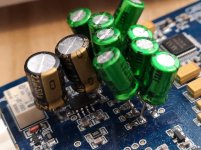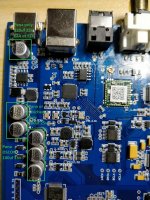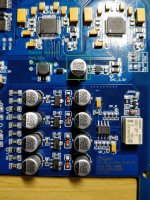The device is in another league now.
What league might that be, now as good as a D50?
I am curios, how we can connect Sabre DAC via I2C at ports 0x90; 0x92 and use native GUI (Windows PC) to control registers.
It could be done by various means. Cheapest way would probably be to use something like an Arduino or other low-cost MCU that could appear as a USB-based serial port device. You could use a terminal emulator like the freeware 'putty' to talk to it.
More expensive, but still pretty quick and easy would be to use something like LabView and some of their hardware boards for which Windows drivers already exist.
Probably the most difficult and time consuming would be to write a Windows device driver for some custom USB to I2C hardware interface and develop a front end GUI app to use with it.
I use the first method above at this point.
Something very similar could be done for configuring AK dac chips too. The same basic methods apply.
Last edited:
I wait for you review.
For small coupling caps, I prefer the Nichicon Muse ES. I also recommend you remove the ceramic cap decoupling the opamp. I remove both the ceramic and the tan cap and replace with Nichicon KZ and the mod give a less clinical sound.
The sparkos already removes the clinical feeling of the sound. But just curious which value KZ did you use?
What league might that be, now as good as a D50?
I haven't heard the D50 yet. Khadas performs similar in the measurements using the same chip.. So let's see how that one performs.
But what I can say is that the modded DX3 Pro now easily outperforms my tuned LKS ES9018. The only thing it doesnt do better is bass. The LKS ES9018 goes deeper
So it will be interesting to see if I can improve this a bit more.
Have you heard the DX3 Pro personally?
Have you heard the DX3 Pro personally?
Can't say that I have. But, easy to believe you are getting some good improvements relatively quick and easy. I just say that because with low cost DACs, usually the first few mods will give most of the easy improvements. After that they often tend to get more complicated and or costly, and eventually at some point the improvements get smaller and smaller as the best the chip can do is starting to be approached.
Can't say that I have. But, easy to believe you are getting some good improvements relatively quick and easy. I just say that because with low cost DACs, usually the first few mods will give most of the easy improvements. After that they often tend to get more complicated and or costly, and eventually at some point the improvements get smaller and smaller as the best the chip can do is starting to be approached.
I agree. I think I have a already made the most significant improvements and I'm already perfectly happy with the result. But there are a few more things that I can do for some minor improvements.
Improve the PSU for stability and power delivery.
Improve clocks
Improve headphone amp
Try transformer output instead of opamp
Except for the transformers they are small mods and I except deminishing returns after this. I think the biggest design flaw was the use of those small 33uf caps at the DAC output. Replacing them and increasing the caps at the opamp voltage rails really improved most.
What I miss now is deep bass. My quest continues for deep bass frequencies.
I have to clarify, If I play my plasticman tracks which have great extended lower frequencies I do hear a tight firm bass but it's just not that deep and chest pumping as with my ES9018. The QMS Q5 (also sold as Emotiva Airmotiv 5) are famous for their powerful low end and I used the have this WOW feeling of feeling the room vibrating and my chest pumping. That is gone. Like it doesn't go as low in the frequency spectrum. I still hear the windows resonating and screws vibrating on the desk. But clearly not the same.
The ES is highly tuned and using only high-end caps. and I/V stage has CCS.
The question is if this difference is chip related or circuit design related.
What I can do is replace the PSU input cap with a 220uf polymer and the other 2 on the 5V rail with two 100uf polymer caps for the USB input. And for the 3.3V DAC input also increase in size to 220uf poly or just same value 100uf poly.
What do you think?
The ES is highly tuned and using only high-end caps. and I/V stage has CCS.
The question is if this difference is chip related or circuit design related.
What I can do is replace the PSU input cap with a 220uf polymer and the other 2 on the 5V rail with two 100uf polymer caps for the USB input. And for the 3.3V DAC input also increase in size to 220uf poly or just same value 100uf poly.
What do you think?
Attachments
Last edited:
Today I had a moment of realisation that I was listening to the modded DX3 for quite a while on a high volume with a random playist on my active speakers and suddenly realised that I wasn't fatigued by it and the sound was really smooth and precise and musical. Then I turned the volume down and listened a while on low volume and still the music came out equally precise and musically pleasing and effortless.
Hey Cidious
So have you heard any quality jump from 44.1K to DSD512? How about the difference between DSD512 and PCM 705K?
You may want to try a mellow OP such as MUSE (cheaper SMT version) to see if it gets any better.
Currently I'm getting a pop out of the right channel everytime the relay switches.. so when I switch sample rate or turn on or off the device.. and some noise on the right channel. I'll have to troubleshoot this first.
UPDATE:
After the device cooled down for a bit the problem is gone. The problem will reappear after a few minutes. indicating some heat issue. On the right channel I struggle to get one of the DAC input caps in and overheated it. Probably it's faulty. I see if replacing it will solve it.
UPDATE:
After the device cooled down for a bit the problem is gone. The problem will reappear after a few minutes. indicating some heat issue. On the right channel I struggle to get one of the DAC input caps in and overheated it. Probably it's faulty. I see if replacing it will solve it.
Last edited:
I have to clarify, If I play my plasticman tracks which have great extended lower frequencies I do hear a tight firm bass but it's just not that deep and chest pumping as with my ES9018. The QMS Q5 (also sold as Emotiva Airmotiv 5) are famous for their powerful low end and I used the have this WOW feeling of feeling the room vibrating and my chest pumping. That is gone. Like it doesn't go as low in the frequency spectrum. I still hear the windows resonating and screws vibrating on the desk. But clearly not the same.
The ES is highly tuned and using only high-end caps. and I/V stage has CCS.
The question is if this difference is chip related or circuit design related.
What I can do is replace the PSU input cap with a 220uf polymer and the other 2 on the 5V rail with two 100uf polymer caps for the USB input. And for the 3.3V DAC input also increase in size to 220uf poly or just same value 100uf poly.
What do you think?
In you image above the ak4493 dac, I did a search on the ak4493 ldo "S2RA" and I think it is the chinese MicrOne LDO. Maybe can replace this ldo to something better?
The input is 5.5V and outputs 3.3V to the dac. There is also a 5V supply somewhere.
https://datasheet.lcsc.com/szlcsc/Nanjing-Micro-One-Elec-ME6211C33M5G-N_C82942.pdf
Last edited:
In you image above the ak4493 dac, I did a search on the ak4493 ldo "S2RA" and I think it is the chinese MicrOne LDO. Maybe can replace this ldo to something better?
The input is 5.5V and outputs 3.3V to the dac. There is also a 5V supply somewhere.
https://datasheet.lcsc.com/szlcsc/Nanjing-Micro-One-Elec-ME6211C33M5G-N_C82942.pdf
Which photo? which position?
Hey Cidious
So have you heard any quality jump from 44.1K to DSD512? How about the difference between DSD512 and PCM 705K?
You may want to try a mellow OP such as MUSE (cheaper SMT version) to see if it gets any better.
No way the MUSE is better than Sparkos! I'm perfectly happy with my opamp choice.
I will replace the ceramic and 33uf cap at the voltage rail though. But after spring festival when I can get some new caps I'm stuck now not being able to order new stuff.
Last mods I can do is put the Oscons and 220uf hybrid poly caps.
Which photo? which position?
Above the ak4493, there is a label DAC_3.3v. It's the small 5 pin smd ic next to that. It's a 3.3V ldo from 5.5v input.
From the datasheet, I think can use Analog Device ADP151 as a direct replacement . ADP151 has better noise spec at 9uV compare to 50uV of the MicrOne .
Last edited:
No way the MUSE is better than Sparkos! I'm perfectly happy with my opamp choice.
I will replace the ceramic and 33uf cap at the voltage rail though. But after spring festival when I can get some new caps I'm stuck now not being able to order new stuff.
Last mods I can do is put the Oscons and 220uf hybrid poly caps.
The excellent Sparkos is more like an audio amp, due to its lower open gain and gain bandwidth. MUSE is an OP. Both should have different sound signatures. It will be interesting to compare the two.
Something I have done on a couple DACs and an SD player was to use a .01uf COG as the last cap before the clock on the power pin. Your results may vary, but I have a feeling the rest of that circuit wil cooperate.
Those tantalum capacitors never sounded that great to me, especially on any analog supply, I would try and tack on some high quality electrolytic parts in those spots.
It’s odd that removing such tiny ceramic parts from the op amp power would make that much difference, I would be hesitant to go without any hf compensation at all, I would want to try a tiny film cap across the power pins, sometimes that works better than power to ground. I think it has something to do with having a noisy ground in those situations.
Those tantalum capacitors never sounded that great to me, especially on any analog supply, I would try and tack on some high quality electrolytic parts in those spots.
It’s odd that removing such tiny ceramic parts from the op amp power would make that much difference, I would be hesitant to go without any hf compensation at all, I would want to try a tiny film cap across the power pins, sometimes that works better than power to ground. I think it has something to do with having a noisy ground in those situations.
I think it has something to do with having a noisy ground in those situations.
Opamps create noise on their power rails by virtue of having classAB output stages. The amount of noise depends on the loading of the opamp's output. The noise on the rails couples to GND via decoupling caps to GND. To make opamps sound good I've found its necessary to maintain strict hygiene between signal GND and power (decoupling) GND but in general you'll find DAC designers using a single groundfill to do double duty.
- Status
- This old topic is closed. If you want to reopen this topic, contact a moderator using the "Report Post" button.
- Home
- Source & Line
- Digital Line Level
- [Modding] Topping DX3 Pro


